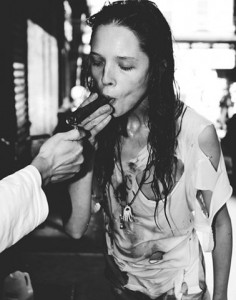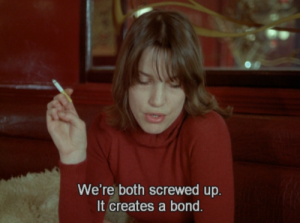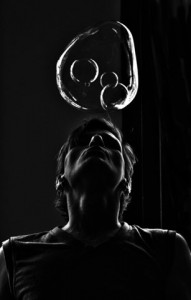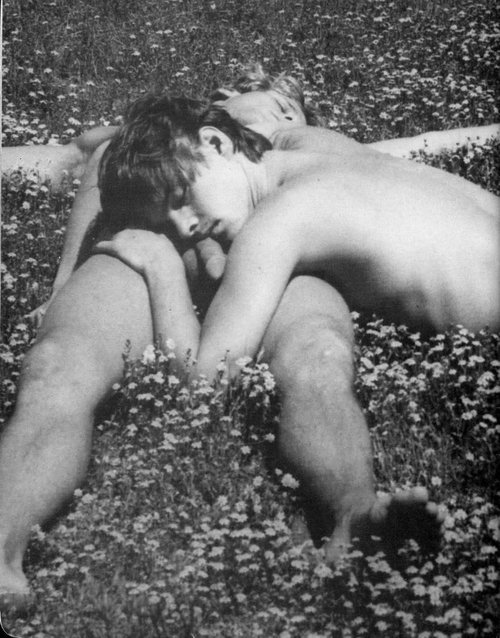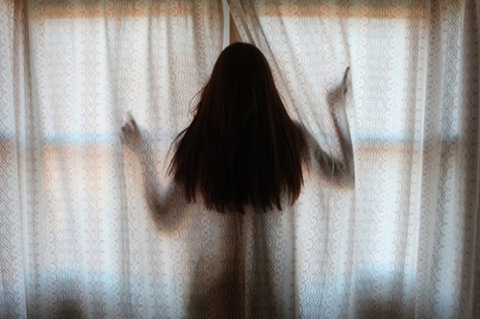Kindly translated by Zuzana Skardová and Tomas Tetiva
To light up oneself.
After many shorts films and full-length documentaries—Tom, Panic Bodies, Imitations of Life and House of Pain—Canadian filmmaker, producer and performer Mike Hoolboom again lights up himself, his answers and questions, in his brand new film Public Lighting. His work is a continuous, almost hypnotic meditation, which finds its optimal thought-wavelength where pictures, feelings, past, future, words and silence flow through. Hoolboom requisitions the most fitting cinematographic styles, and with this tool he can find the shape in things and people which lift him into a distinguished position not only in the Canadian documentary film.
He utilizes a style of associative, timeless stratification or whirling, where all the time layers live within each other, locked in a geyser of images “taken out” of old film sequences, from classic films, home-made videos and even from newly made images, creating a dreamy-painful collage which is called human life. There’s no border between past, presence and future, there are just different streams in the same moment, they dive into one another, take what they want and come back to their direction, into their calm or into their panic. From every image, from each of their interconnections and compositions, pulsates Hoolboom’s sense for intimacy of the image and for cinematic innovation, proofs of which may be found piled in clusters from beginning to end of the 77-minute footage. Everything in his hands becomes part of a magic illumination. In the same way that events spontaneously flow in meditation, Hoolboom’s films pour into each other because there are always the same issues flowing through the author—the body and its borders, crossed by other people and by illnesses, by decaying and death, desire, passion, the private and the public, the modern world and the way in which life is disclosed, created or vanished in the eternal circle of images. (“The pictures never stop. The taking never ends.” Part 7: Amy) Panic Bodies talks about the experience of the human body worn and frayed by AIDS, Imitations of Life talks about the past in the future and vice versa using cut-ups of films from the Lumiéres to contemporary Hollywood.
In Public Lighting a young writer describes her/his intention in the prologue; she intends to expose six different human characters, six sorts of personalities, which are universal and into which all people can be divided. It is only through division that we are able to see reality, or at least the light emitted in the public. The young writer, who recites her art manifesto in a slow, calm voice, is the director’s alter ego. “”The words don’t come from me, they come from other books, conversations with friends. I arrange them, that’s all. That’s all a writer can ever do.” The writing can be exchanged for the images and sounds, light and dark. The initial thesis of the six different personalities is rather a pretext for the meditation on one particular feeling, on one thought with different variations, which is formally divided, as is common for Hoolboom’s style, into several chapters, seven in this case. As he said in connection with Panic Bodies: “The film, like my body, has different parts. It’s a film which addresses AIDS, a virus which occupies and amends the body (a dangerous and unwanted supplement, a new kind of cellular division) that’s why the film arrives in fragments.” Memories and thoughts fragment the body, the mind and the personal history. The chapters (bigger fragments) are split into myriads of smaller fragments which are held together by the imagination (shattering of the whole is for Hoolboom one of the important issues). Hoolboom is fascinated by human personality (“To see the shapes behind people”), how it was created, whereby it is pushed and pulled, what is it that it can’t avoid, what it can’t escape, what is in its past, in the past of its past…
Physical and mental integrity is perceived in the same way, both may fall apart under unreasonable demands, or the failure to find an appropriate picture to carry on. In the City (chapter 2) shows how our surroundings absorb us in its discourses and in its definition of us inside itself. We live in somebody else’s sentences (chapter 5: Tradition), in somebody else’s images, and therefore it is so important to keep our own collection of images that will not disappear, that will not be forgotten, erased, so that we didn’t have to ask someone else who we actually are. (“My memories don’t belong to me anymore.“ Chapter 7: Amy). Different existences intersect and interfere as private becomes public (chapter 2: In the city), inside the city personal stories take place and an intersection is created through time and motion. Each location fosters a new relationship, new demands, the inside surrounds us. In this black and white and grey city the ghosts of negatives turn up, their existences settling between the cracks of the living in a continual flow of time. On the surface of the image (there are only surfaces, we have all become pictures) the public literally passes through the private.
Behind these personal stories Hoolboom discloses important levels of general morality, attitudes towards important social issues (AIDS in the chapter about Madonna or the atomic bomb in the chapter entitled Hiro). By opening personal secrets, he offers a look on the naked mind, on the emotions that form human beings, on the mechanisms that successively order the images in our mind as if playing tape forwards and backwards and through which we try wade to find our own identity. “When I’m writing I see the shapes behind people. The six ways we have to say yes, to open. Six kinds of sadness. We try to conduct these emotions, to write them.” The shapes are not always seen, identity becomes vague, indistinct, even opaque. Each voice and the patterns of living they describe assume different forms: music, dance, silence… The fragments interconnect in a slow whirl.
Wholeness can appear in several tones/ways, repeated infinitely with small variations like the compositions of Philip Glass (chapter 3: Glass) or invented in borrowed styles like Madonna (chapter 4: Hey Madonna). The universal mechanism of being may be the director’s answer to the question of human existence, a profound identification with the present. “I am this cigarette, this shirt, this apartment. I know who I am by the choices I make, the world is my mirror and when I get tired of one personality I reach into my jeans and buy another.“ The composer is already music. The filmmaker already film. Hoolboom says: It isn’t the melody of Glass’s music people listen to and by which they are fascinated, but its insistency itself. I add: these are not just images tagged together with formal perfection and artistic skill, but their insistency which lights up not only Hoolboom’s creation, but also the people who watch it.
